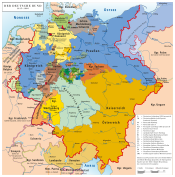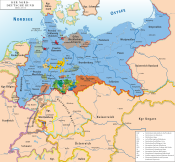Saxe-Meiningen
This article needs additional citations for verification. (May 2007) |
Duchy of Saxe-Meiningen (1680–1918) Herzogtum Sachsen-Meiningen Free State of Saxe-Meiningen (1918–1920) Freistaat Sachsen-Meiningen | |||||||||
|---|---|---|---|---|---|---|---|---|---|
| 1680–1920 | |||||||||
| Anthem: Bernhard III (last) | |||||||||
| Historical era | German Revolution | 1918 | |||||||
• Merged into Thuringia | 1920 | ||||||||
| |||||||||
Saxe-Meiningen (/ˌsæks ˈmaɪnɪŋən/ SAKS MY-ning-ən; German: Sachsen-Meiningen [ˌzaksn̩ ˈmaɪnɪŋən]) was one of the Saxon duchies held by the Ernestine line of the House of Wettin, located in the southwest of the present-day German state of Thuringia.
Established in 1681,[1] by partition of the Ernestine Duchy of Saxe-Gotha among the seven sons of deceased Duke Ernest the Pious, the Saxe-Meiningen line of the House of Wettin lasted until the end of the German monarchies in 1918.[2]
History

House of Wettin
The
Duchy of Saxe-Meiningen
Bernhard, Ernst I's third son, received the town of Meiningen as well as several other holdings (Wasungen und Salzungen, Maßfeld und Sand, Herrenbreitungen, Herpf, Stepfershausen, Utendorf, Mehlis and the former Franconian lands of the extinct House of Henneberg, Henneberg).[2]
Bernhard chose the town of Meiningen as his residence and became the first duke of Saxe-Meiningen. From 1682 Duke Bernhard I had the
In the reshuffle of Ernestine territories that occurred following the extinction of the Saxe-Gotha-Altenburg line upon the death of Duke Frederick IV in 1825, Duke Bernhard II of Saxe-Meiningen received the lands of the former Duchy of Saxe-Hildburghausen as well as the Saalfeld territory of the former Saxe-Coburg-Saalfeld duchy.
As Bernhard II had supported Austria in the 1866 Austro-Prussian War, the prime minister of victorious Prussia, Otto von Bismarck, enforced his abdication in favour of his son George II, after which Saxe-Meiningen was admitted to join the North German Confederation.
By 1910, the duchy had grown to 2,468 km2 (953 sq mi) and 278,762 inhabitants.[2] The ducal summer residence was at Altenstein Castle. Since 1868, the duchy comprised the Kreise (districts) of Hildburghausen, Sonneberg and Saalfeld as well as the northern exclaves of Camburg and Kranichfeld.
End of the Duchy
In the
Dukes of Saxe-Meiningen
- Bernhard I (1680–1706)
- Ernst Ludwig I(1706–24), son of Bernhard I
- Ernst Ludwig II(1724–29), son of Ernst Ludwig I
- Karl Friedrich(1729–43), son of Ernst Ludwig I
- Friedrich Wilhelm(1743–46), son of Bernhard I
- Anton Ulrich (1746–63), son of Bernhard I
- Karl Wilhelm(1763–82), son of Anton Ulrich
- George I (1782–1803), son of Anton Ulrich, father of Queen Adelaide
- Bernhard II (1803–66), son of Georg I
- Georg II (1866–1914), son of Bernhard II
- Bernhard III (1914–18), son of George II[2]
Notes:
- Friedrich Wilhelm and Friedrich II of Saxe-Gotha reigned as guardians for the minor Karl Friedrich in 1729–1733
- Friedrich Wilhelm and Anton Ulrich reigned jointly in 1743–46
- Charlotte Amaliereigned as regent/guardian for the minors Karl Wilhelm und Georg I in 1763–82
- Luise Eleonorereigned as regent/guardian for the minor Bernhard II in 1803–1821
- Dukedom abolished in 1918.[2]
See also
References
- ^ Herbermann, Charles, ed. (1913). . Catholic Encyclopedia. New York: Robert Appleton Company.
- ^ a b c d e f g h "Die herzogliche Familie (German)". Meininger Museen. Archived from the original on 18 August 2017. Retrieved 10 May 2019.
External links
- Chisholm, Hugh, ed. (1911). . Encyclopædia Britannica (11th ed.). Cambridge University Press.







